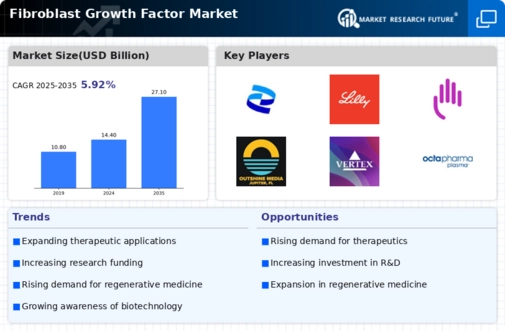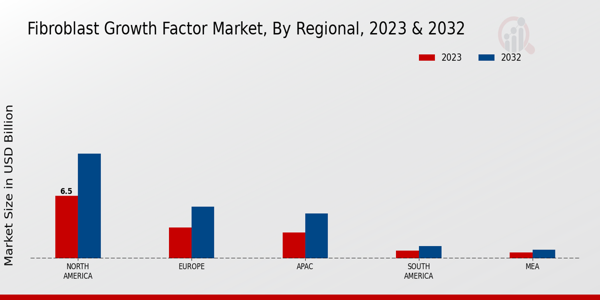Market Growth Projections
The Global Fibroblast Growth Factor Market Industry is characterized by robust growth projections, indicating a promising future. The market is anticipated to reach a valuation of 27.1 USD Billion by 2035, driven by various factors including technological advancements and increasing healthcare needs. The projected CAGR of 5.92% from 2025 to 2035 underscores the sustained interest in fibroblast growth factors across multiple therapeutic areas. This growth trajectory suggests a dynamic market landscape, where innovations and research breakthroughs are likely to shape the future of fibroblast growth factor applications. The ongoing commitment to exploring these factors will likely enhance their therapeutic relevance.
Advancements in Biotechnology
Technological advancements in biotechnology are propelling the Global Fibroblast Growth Factor Market Industry forward. Innovations in genetic engineering and molecular biology are enabling the development of more effective fibroblast growth factor therapies. These advancements facilitate the production of recombinant proteins, which are crucial for therapeutic applications. The market is expected to grow at a CAGR of 5.92% from 2025 to 2035, indicating a robust future for biotechnological applications in this field. Enhanced understanding of fibroblast growth factor mechanisms is likely to lead to novel treatment modalities, further driving market expansion and attracting research funding.
Rising Demand for Regenerative Medicine
The Global Fibroblast Growth Factor Market Industry is experiencing a surge in demand driven by the increasing focus on regenerative medicine. This sector aims to repair or replace damaged tissues and organs, leveraging the properties of fibroblast growth factors. As of 2024, the market is valued at 14.4 USD Billion, reflecting a growing recognition of the potential therapeutic applications of these factors in treating various conditions. The regenerative medicine market is projected to expand significantly, with fibroblast growth factors playing a pivotal role in enhancing healing processes and tissue regeneration, thus attracting substantial investments and research initiatives.
Increasing Prevalence of Chronic Diseases
The rising prevalence of chronic diseases globally is a significant driver for the Global Fibroblast Growth Factor Market Industry. Conditions such as diabetes, cardiovascular diseases, and chronic wounds necessitate innovative treatment approaches, where fibroblast growth factors can play a crucial role. These factors are known to promote angiogenesis and tissue repair, making them vital in managing chronic conditions. As healthcare systems increasingly focus on effective management strategies, the market is projected to reach 27.1 USD Billion by 2035, highlighting the growing recognition of fibroblast growth factors in therapeutic applications for chronic disease management.
Emerging Applications in Aesthetic Medicine
The Global Fibroblast Growth Factor Market Industry is witnessing emerging applications in aesthetic medicine, which is becoming a notable driver of market growth. Fibroblast growth factors are increasingly utilized in cosmetic procedures aimed at skin rejuvenation and anti-aging treatments. The demand for non-invasive aesthetic procedures is on the rise, as consumers seek effective solutions for skin health. This trend is expected to contribute to the market's expansion, with a projected value of 14.4 USD Billion in 2024. The integration of fibroblast growth factors in aesthetic applications reflects a broader acceptance of their therapeutic potential, further solidifying their role in the healthcare landscape.
Growing Investment in Research and Development
Investment in research and development is a critical driver for the Global Fibroblast Growth Factor Market Industry. Governments and private entities are increasingly funding research initiatives aimed at exploring the therapeutic potential of fibroblast growth factors. This influx of funding supports clinical trials and the development of novel therapies, enhancing the understanding of fibroblast growth factor mechanisms. As a result, the market is poised for substantial growth, with projections indicating a market value of 27.1 USD Billion by 2035. The commitment to advancing research in this area is likely to yield innovative treatments and expand the applications of fibroblast growth factors.






















